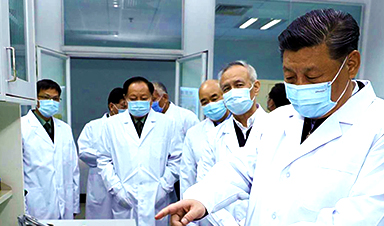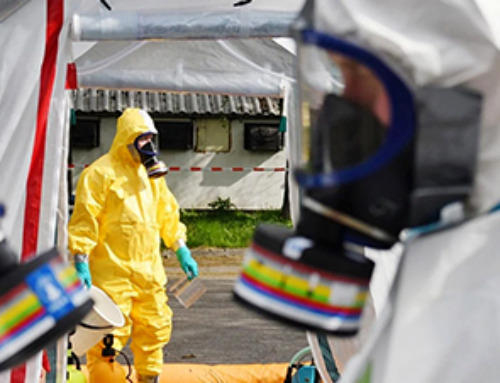Medical researchers with the Chinese army engineered mice with humanized lungs in 2019 to test viruses on them, it has been reported.
The mice, developed using CRISPR gene-editing technology, were mentioned in an April 2020 study which researched their susceptibility to SARS-CoV-2, the virus that causes the COVID-19 illness, Vanity Fair revealed in its bombshell investigation.
Of the study's 23 co-authors, 11 of them worked for the Academy of Military Medical Sciences, the medical research institute for the Chinese army.
Investigators with the U.S. National Security Council, researching the origins of the pandemic, determined that the mice referenced in the study were created in the summer of 2019 – just months before the emergence of the pandemic.
The National Security Council investigators also reportedly believed they had 'uncovered important evidence' supporting the theory that COVID-19 had leaked from a lab and began reaching out to other federal agencies, Vanity Fair reported.
'We were dismissed. The response was very negative,' said Anthony Ruggiero, the a senior director at the National Security Council.
Shi Zhengli, the Wuhan Institute of Virology lead researcher on coronaviruses known as the 'Bat Woman' for her research on bat viruses, appears to have tested at least two novel coronaviruses on humanized mice in the last three years, Vanity Fair also revealed – citing comments she made to a scientific journal and grant information.
Shi has refuted claims that COVID-19 leaked from a lab at the Wuhan Institute of Virology and that the facility conducts military research.
However, Shi was interviewed in a Scientific American article, first published in March 2020, in which she recounted how she 'frantically went through her own lab's records from the past few years to check for any mishandling of experimental materials, especially during disposal.'
Shi was relieved when none of the genetic sequences from patients with COVID-19 matched those of the viruses her team had sampled from bat caves.
'That really took a load off my mind. I had not slept a wink for days,' Shi told the outlet.
In January, the State Department released a fact sheet slamming the Chinese Communist Party of 'systematically' preventing a 'transparent and thorough investigation of the COVID-19 pandemic's origin.'
The State Department acknowledged in the fact sheet at the time that the virus 'could have emerged naturally from human contact with infected animals.'
'Alternatively, a laboratory accident could resemble a natural outbreak if the initial exposure included only a few individuals and was compounded by asymptomatic infection,' the fact sheet reads.
The State Department noted that the Wuhan Institute of Virology has 'collaborated on publications and secret projects with China's military' while 'presenting itself as a civilian institution.'
'The WIV has engaged in classified research, including laboratory animal experiments, on behalf of the Chinese military since at least 2017,' the sheet reads.
News
Does being infected or vaccinated first influence COVID-19 immunity?
A new study analyzing the immune response to COVID-19 in a Catalan cohort of health workers sheds light on an important question: does it matter whether a person was first infected or first vaccinated? [...]
We May Never Know if AI Is Conscious, Says Cambridge Philosopher
As claims about conscious AI grow louder, a Cambridge philosopher argues that we lack the evidence to know whether machines can truly be conscious, let alone morally significant. A philosopher at the University of [...]
AI Helped Scientists Stop a Virus With One Tiny Change
Using AI, researchers identified one tiny molecular interaction that viruses need to infect cells. Disrupting it stopped the virus before infection could begin. Washington State University scientists have uncovered a method to interfere with a key [...]
Deadly Hospital Fungus May Finally Have a Weakness
A deadly, drug-resistant hospital fungus may finally have a weakness—and scientists think they’ve found it. Researchers have identified a genetic process that could open the door to new treatments for a dangerous fungal infection [...]
Fever-Proof Bird Flu Variant Could Fuel the Next Pandemic
Bird flu viruses present a significant risk to humans because they can continue replicating at temperatures higher than a typical fever. Fever is one of the body’s main tools for slowing or stopping viral [...]
What could the future of nanoscience look like?
Society has a lot to thank for nanoscience. From improved health monitoring to reducing the size of electronics, scientists’ ability to delve deeper and better understand chemistry at the nanoscale has opened up numerous [...]
Scientists Melt Cancer’s Hidden “Power Hubs” and Stop Tumor Growth
Researchers discovered that in a rare kidney cancer, RNA builds droplet-like hubs that act as growth control centers inside tumor cells. By engineering a molecular switch to dissolve these hubs, they were able to halt cancer [...]
Platelet-inspired nanoparticles could improve treatment of inflammatory diseases
Scientists have developed platelet-inspired nanoparticles that deliver anti-inflammatory drugs directly to brain-computer interface implants, doubling their effectiveness. Scientists have found a way to improve the performance of brain-computer interface (BCI) electrodes by delivering anti-inflammatory drugs directly [...]
After 150 years, a new chapter in cancer therapy is finally beginning
For decades, researchers have been looking for ways to destroy cancer cells in a targeted manner without further weakening the body. But for many patients whose immune system is severely impaired by chemotherapy or radiation, [...]
Older chemical libraries show promise for fighting resistant strains of COVID-19 virus
SARS‑CoV‑2, the virus that causes COVID-19, continues to mutate, with some newer strains becoming less responsive to current antiviral treatments like Paxlovid. Now, University of California San Diego scientists and an international team of [...]
Lower doses of immunotherapy for skin cancer give better results, study suggests
According to a new study, lower doses of approved immunotherapy for malignant melanoma can give better results against tumors, while reducing side effects. This is reported by researchers at Karolinska Institutet in the Journal of the National [...]
Researchers highlight five pathways through which microplastics can harm the brain
Microplastics could be fueling neurodegenerative diseases like Alzheimer's and Parkinson's, with a new study highlighting five ways microplastics can trigger inflammation and damage in the brain. More than 57 million people live with dementia, [...]
Tiny Metal Nanodots Obliterate Cancer Cells While Largely Sparing Healthy Tissue
Scientists have developed tiny metal-oxide particles that push cancer cells past their stress limits while sparing healthy tissue. An international team led by RMIT University has developed tiny particles called nanodots, crafted from a metallic compound, [...]
Gold Nanoclusters Could Supercharge Quantum Computers
Researchers found that gold “super atoms” can behave like the atoms in top-tier quantum systems—only far easier to scale. These tiny clusters can be customized at the molecular level, offering a powerful, tunable foundation [...]
A single shot of HPV vaccine may be enough to fight cervical cancer, study finds
WASHINGTON -- A single HPV vaccination appears just as effective as two doses at preventing the viral infection that causes cervical cancer, researchers reported Wednesday. HPV, or human papillomavirus, is very common and spread [...]
New technique overcomes technological barrier in 3D brain imaging
Scientists at the Swiss Light Source SLS have succeeded in mapping a piece of brain tissue in 3D at unprecedented resolution using X-rays, non-destructively. The breakthrough overcomes a long-standing technological barrier that had limited [...]





















